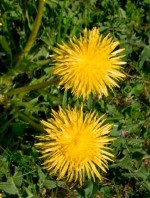 To most gardeners dandelions are pesky weeds but to herbalists they are valuable plants. As early as the tenth-century, Arabian physicians mentioned the plant and by the sixteenth century British pharmacists viewed it as valuable drug. The name dandelion comes from the French dent de lion, meaning lion’s tooth, a reference to the toothed leaves of the plant. Other names are Swine’s snout, Irish daisy, puffball, blowball, peasant’s cloak, and priest’s crown. This last name refers to the green bud that opens golden yellow like the hair of a young priest but matures to white and falls out as the priest ages. ( But why does the name refer to just a priest?)Dandelion roots have been used for centuries to treat diabetes, liver diseases, anemia, and constipation. The plant is said to be a diuretic, aid in digestion, and stimulate the appetite. All parts of the plant are edible; the root is roasted to make a coffee substitute, the flowers to make wine that tastes a little like sherry, and the leaves to use as a salad green or cooked and eaten like spinach (dandelion greens are more nutritious than spinach.) Then consider that the flowers can also be used to make a yellow dye for wool and the whole plant can be used to make a magenta dye; the milky sap can be used as a mosquito repellent and to treat warts. When all the facts are in about dandelion, you have to admit that it is quite a useful plant and perhaps not deserving of our scorn.
To most gardeners dandelions are pesky weeds but to herbalists they are valuable plants. As early as the tenth-century, Arabian physicians mentioned the plant and by the sixteenth century British pharmacists viewed it as valuable drug. The name dandelion comes from the French dent de lion, meaning lion’s tooth, a reference to the toothed leaves of the plant. Other names are Swine’s snout, Irish daisy, puffball, blowball, peasant’s cloak, and priest’s crown. This last name refers to the green bud that opens golden yellow like the hair of a young priest but matures to white and falls out as the priest ages. ( But why does the name refer to just a priest?)Dandelion roots have been used for centuries to treat diabetes, liver diseases, anemia, and constipation. The plant is said to be a diuretic, aid in digestion, and stimulate the appetite. All parts of the plant are edible; the root is roasted to make a coffee substitute, the flowers to make wine that tastes a little like sherry, and the leaves to use as a salad green or cooked and eaten like spinach (dandelion greens are more nutritious than spinach.) Then consider that the flowers can also be used to make a yellow dye for wool and the whole plant can be used to make a magenta dye; the milky sap can be used as a mosquito repellent and to treat warts. When all the facts are in about dandelion, you have to admit that it is quite a useful plant and perhaps not deserving of our scorn.
 The fluffy seed heads spread the dandelion to all parts of the lawn and garden and its long tap root make it especially hard to eradicate. On the positive side, young children love the bright colored flowers and fluffy seed heads so if you want to have fun with a toddler, find some dandelions and let them pick all the flowers they want and blow all the seed heads away into your lawn and garden so you can repeat the experience the following year..
The fluffy seed heads spread the dandelion to all parts of the lawn and garden and its long tap root make it especially hard to eradicate. On the positive side, young children love the bright colored flowers and fluffy seed heads so if you want to have fun with a toddler, find some dandelions and let them pick all the flowers they want and blow all the seed heads away into your lawn and garden so you can repeat the experience the following year..
Type: Herbaceous perennial
Bloom: Golden yellow flower heads are 1 ½” –2 inches across and are borne single on hallow stems summer to fall.
Foliage: Leaves are two to twelve inches long and have heavily toothed margins. They form a rosette close the ground.
Size: 6-12” H x 6-12” W
Light: Full sun to part shade
Soil: Virtually any soil
Hardiness: Zones 5-9
Care: Very fresh or very old greens tend to be more tasty because they have not developed bitterness or have lost their bitterness. Harvest fresh flowers for wine.
Pests and Diseases: None of significance
Propagation: Seed
Companion plants: It is said that dandelions benefit nearby fruit trees.